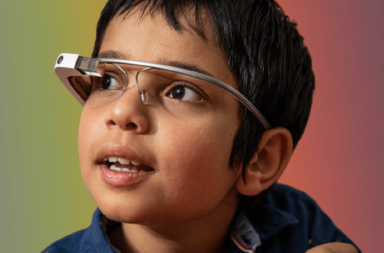What are the different types of autism? No really, what are the different types of autism? This isn’t a rhetorical question (in fact, it’s quite the opposite) because after spending this week searching for a definitive answer as to what the different types of autism are, I have come away with the suspicious feeling that, if we’re honest, no one knows for sure.
Nevertheless, depending on your location in the world and what diagnosis criteria you are using, knowing the different types of autism is a must for finding the correct support. This is why, today, I have done my best to pull together a full list of the different types of autism, as well as where and why a condition finds itself on this ever-changing spectrum.

The Big Three:
Although, the idea of having three prime types of autism is slowly being phased out (and even during its time there were arguments as to whether or not it was a big three or a big four), more often than not, you’ll find that, when someone discusses autism, they’ll have these categories in mind – which are:
1. Autistic disorder
The king of the hill when it comes to autism types, autistic disorder (aka Classic Autism) is a condition which creates deficits in social interaction, developmental language and communication skills. Rather confusingly, autistic disorder is actually a subtype of autistic spectrum disorder – meaning that it used to be possible to have autism but not autistic disorder.
Thankfully, as if to prove there is a God, this odd naming convention was done away with in 2013, when autistic disorder was elevated from a subtype to a catch-all term for the condition. Additionally, during this update, many other external autism typings were folded into autistic disorder, including…
2. Asperger’s Syndrome
Positioned similarly to autistic disorder, a person with Asperger’s is likely to struggle in social circumstances, may form strong repetitive behaviours and will often be sentenced to a life where they are told they are ‘not autistic enough’ to be on the spectrum.
This last point usually comes as a result of many people with Asperger’s having a higher than average IQ something which, while great on paper, often comes with a higher risk of depression, anxiety and suicide – due to many ‘aspies’ bottling up the stress of their internal differences.
3. Pervasive Developmental Disorder, Not Otherwise Specified (PDD-NOS)
So what if you don’t fit into either category of Asperger’s or Autism? Well, for those middle ground enigmas who might meet the criteria in certain areas of the spectrum but not quite cut it in others, there will always be a home in the autistic typing of PDD-NOS (also known as Atypical Autism).
Furthermore, in 2013, PDD-NOS was absorbed into the larger autistic spectrum disorder which means that now PDD-NOS it’s not just a home for those previously left out, but also an up and coming street which gets busier and busier as more condtions flock under the autism banner.
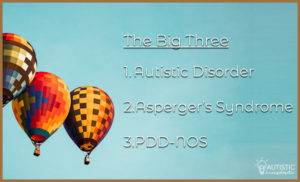
Pervasive Developmental Disorders
Up to now, this is all well known stuff but did you know that autism hasn’t always been a 3 man show? As, just like when the Foo Fighters were born out of Nirvana’s ashes, the autism spectrum was once a part of something much bigger: a 5 condition collaboration characterised by early social and communication deficits called the Pervasive Developmental Disorders (catchy).
Of course, amongst the members of the 5 ‘Pervasive Developmental Disorders’ were the previously mentioned Autistic Disorder, Asperger’s Syndrome and PDD-NOS. However, in it’s heyday it also included two other conditions, which were forced to take different paths as more was discovered about them, namely:
1. Rett’s Syndrome
A developmental condition which only impacts females, Rett’s syndrome was once viewed as a type of autism which additionally caused physical challenges such as growth and movement. However, after the condition was discovered to be as a result of changes within the X chromosome, Rett’s syndrome was moved out of the neurological conditions bracket and into the genetic disorder classification.
2. Childhood Disintegrative Disorder/Heller’s Syndrome/Regressive Autism
Okay, so I’m not going to sugar coat it, those who have found a place on the spectrum due to this last PDD: Childhood Disintegrative Disorder have often been given a raw deal. This is because, those who have CDD, will usually experienece an unimaginable level of distress between the ages of 0-3 when, seemingly out of nowhere, the condition kicks in, causing a quick regression of social and motor skills to the point where sensory processing are often worse than the average autists.
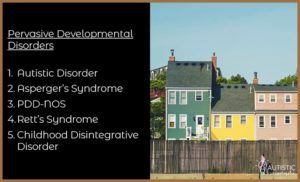
Conditions related to autism
Autism diagnosis doesn’t just begin and end with these 5 conditions though as, like the 2 previous conditions demonstrate, there are many MANY types of diagnosis out there which overlap in the causes and effects of autism.
As such, while you may have seen many things labelled ‘a rare type of autism’ in a newspaper or journal, the reality is that many of these condition are close to the spectrum but not on in. These include:
- Fragile X: A condition similar to autism although with a 2:3 male to female gender split, fragile X differs in that it largely impacts on communication.
- Social Communication Disorder: Also known as Pragmatic Language Disorder in the UK, SCD is a linguistics condition which differs from autism in that, while those with autism will have ‘diffculty’ adusting their speech in social situations, those with SCD will be fully unable to.
- Prader Willis Syndrome: Presented in those with average IQs, Prader Willis Syndrome carries many of the social challenges of autism, as well as many of the mental health risks of Asperger’s.
- Angelman Syndrome: A genetic disorder which causes autistic-like traits i.e. speaking problems as well fascinations/obsessions (usually with water), Angelman Syndrome differs in that it also impacts the appearance and causes challenges with movement.
- Pitt Hopkins Syndrome: A kind of combination of Rett’s Syndrome and autism, Pitt Hopkins syndrome is a condition which presents with all the behavioural, communication and motor challenges of the aforementioned but with additional problems with breathing.
- Pathological Demand Avoidance: A developmental disorder distinct from autism (but nevertheless found a place within the spectrum in 2013), those with Pathological Demand Avoidance will have bouts of extreme social anxiety when given a command i.e. the feeling of lost control can cause them to become aggressive or hyperactive.
- DiGeorge Syndrome: Often compared to autism for having a spectrum of behaviour complications, DiGeorge Syndrome is a condition caused by inheriting missing chunks of DNA, resulting in problems with the kidneys, hearing and auto-immune diseases.
- Cohen Syndrome: Like DiGeorge Syndrome, Cohen syndrome has been linked to autism due to behaviour difficulties. However, unlike autism, those with Cohen’s syndrome will additionally have diminished muscle tone and weak vision.
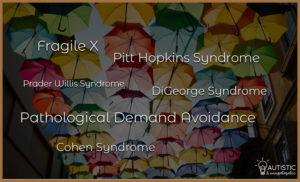
Autism Levels
Autism diagnosis is a strange game and it’s why, after many years of struggling to give a spot on classification, the team behind the latest edition of the diagnostic and statistical manual decided to introduce autism level classification: a numbered tier system which instead of focusing on the symptoms and cause of autism has a diagnosis based on the support they need e.g:
- Level 1: requires support
- Level 2: requires substantial support
- Level 3: requires very substantial support
This new system has helped to create an environment where time isn’t wasted finding the exact name for someone’s traits and, instead, hospital staff can get right to the helping part of the condition. This isn’t foolproof though, as it can make transferring notes from one doctor to another a lot more complicated – due to the doc having to research the patient and not recall the condition.
Although this is as far at the autism diagnosis story goes, don’t be surprised if levels of support one day go the way of the dodo; potentially being reverted back to the old system, in which every Tom, Dick and Harry gets a syndrome named after them or perhaps, a new one entirely which will ultimately be fated to become as convaluted as those that went before it.
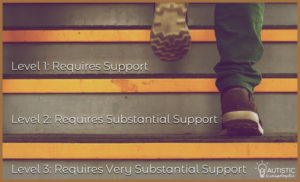
Carry on the Conversation:
What do you think of the autism level system? Let me know in the comments below. And, if you would like to see some awesome examples of the varying autism types, then check out Underdogs, a new young adult which I recently reviewed here.
As always, I can also be found on Twitter @AutismRevised and via my email: AutisticandUnapologetic@gmail.com.
If you like what you have seen on the site today, then show your support by liking the Autistic & Unapologetic Facebook page. Also, don’t forget to sign up to the Autistic & Unapologetic newsletter (found on the sidebar on laptops and underneath if you are reading this via mobile) where I share weekly updates as well as a fascinating fact I have found throughout the week.
Thank you for reading and I will see you next Saturday for more thoughts from across the spectrum.


